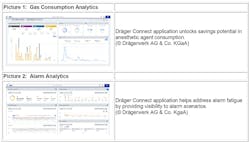Analysis of anesthetic consumption unlocks potential for savings, protective therapies and lower greenhouse gases
Dräger has developed two new software solutions to optimize clinical processes, according to their press release. Building on the Dräger Connect Data Analytics platform, the Gas Consumption Analytics application enables healthcare systems to analyze the technical logbooks of all Dräger anesthesia machines in the Perseus A500.
The application provides an overview of consumption and the resulting costs of individual anesthetic agents, as well as the fresh gas flows used on the machines. It also offers a comparison between anesthetic gas consumption and the intake by patient for each machine.
The gas consumption analysis helps to reduce costs by optimizing procurement expense. Because anesthetic gases damage the ozone layer, efficient use of volatile anesthetic agents with low-flow anesthesia can also reduce a hospital’s CO2-equivalent emissions. Furthermore, observation results of monitoring low-flow anesthesia show advantages for the patient. For example, low-flow maintains the moisture and heat content of the breathing gases This supports the function of the airway epithelium, which is required for mucociliary clearance (self-cleaning process of the bronchial tubes).
Besides reducing the consumption of anesthetic agents, Dräger Connect is also an efficient tool in alarm reduction. At the moment, excessive alarms with no clinical relevance in intensive and intermediate care stations are placing unnecessary stress on staff and patients. Studies have shown that 95% of the up to 350 alarms triggered by monitoring systems in an intensive care unit (ICU) each day are clinically irrelevant.
The Dräger Alarm History Analytics application offers guidance by first providing a detailed overview of past alarm messages. The software can, for example, be used to display alarms by severity, type or distribution, turning alarm auditing into an important decision-making tool when staffing the department. The program supports clinical standard operating procedures (SOP) for a hospital’s alarm management strategy. In addition, the effect of the measures taken to reduce alarm fatigue can subsequently be assessed.
The alarm analysis therefore contributes to a hospital’s alarm strategy that permanently reduces a constantly high noise level. Moreover, Dräger advises hospitals on the analysis of the current situation and helps define requirements for an alarm system and implement a plan that improves how alarms are handled. The Alarm History Analytics application can then be used to review the effectiveness of process optimizations.
